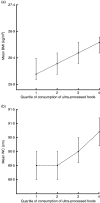Consumption of ultra-processed food and obesity: cross sectional results from the Brazilian Longitudinal Study of Adult Health (ELSA-Brasil) cohort (2008-2010)
- PMID: 29642958
- PMCID: PMC11106008
- DOI: 10.1017/S1368980018000861
Consumption of ultra-processed food and obesity: cross sectional results from the Brazilian Longitudinal Study of Adult Health (ELSA-Brasil) cohort (2008-2010)
Abstract
Objective: To verify if the intake of ultra-processed foods is associated with higher BMI and waist circumference (WC) among participants of the Brazilian Longitudinal Study of Adult Health (ELSA-Brasil) cohort.
Design: Cross-sectional analysis of the ELSA-Brasil baseline (2008-2010). Dietary information obtained through an FFQ was classified according to characteristics of food processing (NOVA) and used to estimate the percentage energy contribution from ultra-processed foods (i.e. industrial formulations, elaborated from food processing, synthetic constituents and food additives) to individuals' total energy intake. BMI and WC and their respective cut-off points served as response variables. Associations were estimated through linear and multinomial logistic regression models, after adjusting for confounders and total energy intake.
Setting: Six Brazilian capital cities, 2008-2010.
Subjects: Active and retired civil servants, aged 35-64 years, from universities and research organizations (n 8977).
Results: Ultra-processed foods accounted for 22·7 % of total energy intake. After adjustments, individuals in the fourth quartile of percentage energy contribution from ultra-processed foods presented (β; 95 % CI) a higher BMI (0·80; CI 0·53, 1·07 kg/m2) and WC (1·71; 1·02, 2·40 cm), and higher chances (OR; 95 % CI) of being overweight (1·31; 1·13, 1·51), obese (1·41; 1·18, 1·69) and having significantly increased WC (1·41; 1·20, 1·66), compared with those in the first quartile. All associations suggest a dose-response gradient.
Conclusions: Results indicate the existence of associations between greater energy contribution from ultra-processed foods and higher BMI and WC, which are independent of total energy intake. These findings corroborate public policies designed to reduce the intake of this type of food.
Keywords: ELSA-Brasil; Food consumption; Obesity; Ultra-processed foods; Waist circumference.
Figures

References
-
- World Health Organization (2016) Obesity and overweight. Fact sheet no. 311. http://www.who.int/mediacentre/factsheets/fs311/en/# (accessed June 2016).
-
- GBD 2015 Risk Factors Collaborators (2016) Global, regional, and national comparative risk assessment of 79 behavioural, environmental and occupational, and metabolic risks or clusters of risks, 1990–2015: a systematic analysis for the Global Burden of Disease Study 2015. Lancet 388, 1659–1724. - PMC - PubMed
-
- Brazilian Institute of Geography and Statistics (2011) Search for Family Budgets 2008–2009: Analysis of Personal Food Consumption in Brazil. Rio de Janeiro, RJ: IBGE.
Publication types
MeSH terms
LinkOut - more resources
Full Text Sources
Other Literature Sources
Medical

